Welcome
In this issue of Wild Edition, find out what it takes to hand-rear baby animals in our featured story, Bringing up Baby, then take a peek at some changes happening in our Herpetarium. Get animal updates on some of our most recent newborns, and make sure to reserve your spot at our upcoming events!
Bringing up baby
There's more to hand-rearing baby animals than meets the eye
There’s hardly anything cuter than a baby animal — whether it’s an infant primate clinging to its mother, a lion cub practicing its pouncing, or a baby giraffe learning to walk on wobbly legs. Dallas Zoo visitors and staffers alike are captivated by these pint-sized creatures.
Before these little ones even arrive, Dallas Zoo staff is hard at work behind the scenes planning and prepping to make sure baby animals have everything they need to thrive, including:
- Adjusting the diets of pregnant and nursing mothers to boost calorie intake to support new life
- Setting up nesting boxes where expectant mothers can give birth
- Having backup infant formula and baby food on hand in case mom isn’t producing enough milk or can’t feed the baby for other reasons
- Procuring the right feeding apparatuses for each species, which includes bottles and nipples of various shapes and sizes
- Rearranging staff schedules in case pregnant or nursing mothers or newborn babies need extra care
“We plan for worst-case scenarios and how to handle them,” said Lisa Van Slett, assistant curator of mammals at the Dallas Zoo. “Even with our planning, animals still throw us for a loop sometimes — a big part of my job is adapting in the moment.”
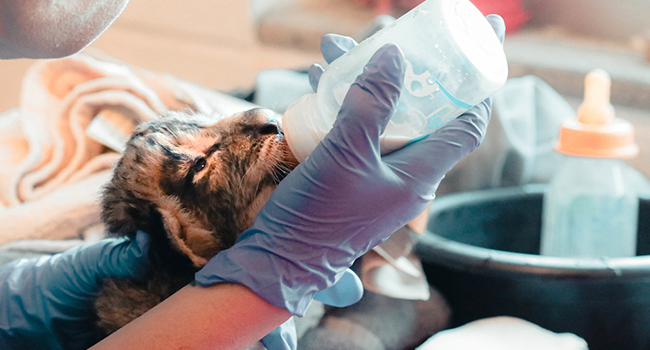

When babies need extra support
Sometimes mom can’t care for her new baby, and staff must jump in to hand-rear the baby animal during its critical first months or years of life, with the goal of reuniting the baby with its family later on.
“With first-time moms, we have to be ready for pregnancy complications. Sometimes we have to deal with stillborns, or parents will reject the baby because they don’t know how to raise it, or mom just simply doesn’t produce enough milk to sustain them,” Van Slett explained.
Although human intervention is sometimes necessary to combat naturally high infant mortality rates, Van Slett stressed that “We always prefer babies to be raised by their mothers. We want them to learn natural behaviors without needing much assistance from humans,” she said.
Typically, staff encourage the mother to raise its young over multiple attempts, or they’ll look for surrogate parents from the same species. If all else fails, “hand-rearing is the last resort,” she said.
The Dallas Zoo has intervened a handful of times in recent years, most notably hand-rearing tiger cubs Sumini, Rudi, and Nety, and lion triplets Ilola, Izwi, and Tadala. All of these cubs were born to first-time moms who struggled to produce enough milk to sustain the babies.
Some animals only need supplemental feeding or a short intervention, like the hoof stock species ibex and gerenuk, who had babies that were partially raised on bottles — or recent emperor tamarin babies who were hand-reared for a month before being reintroduced to mom and dad.
The Zoo coordinates with the Species Survival Plan (SSP) on how to best raise these youngsters. “They typically have detailed information on each species: how much and how often they should be fed, their growth trajectory, what to look out for, and ways to reunite the mom with the baby,” Van Slett said. “The SSP gathers information from zoos throughout the country and pools all of that info together for us all to use as a resource when needed.”
Around-the-clock Kip
A baby gibbon named Kip is a good example of the lengths that staffers have taken to ensure the success of each baby animal born at the Zoo.
“The major difference between Kip and every other baby we’ve cared for is that lesser apes, such as gibbons, need constant care. Someone has to hold him at all times,” Van Slett explained. Even though it’s hard to imagine, “he’s been in someone’s arms 24 hours a day since he was born on August 11.” Van Slett’s staff is logging a ton of overtime.
In a 24-hour period, Kip is bottle-fed 12 times, or every two hours. In October, he was just starting to eat solid foods like pureed banana, carrot, and sweet potato.
“We acclimate him just like you’d introduce a human baby to solid food,” said Kerri Slifka, curator of nutrition, who oversees the diets for about 2,000 animals across the Dallas Zoo. “Kip has to get used to chewing food and swallowing — it’s a new concept for him,” she said.
Kip’s caregivers take detailed notes throughout the day and communicate with Slifka about his weight, eating habits, and elimination frequency to ensure he’s on the right track.
“The first thing I do in the morning is look at what happened the day before,” Slifka said. Everything is entered into a spreadsheet so Slifka can run calculations and make adjustments as needed.
“If something’s wrong, I get a call immediately,” Slifka said. “Caring for a baby animal is a team effort — it really does take a village.”
Just like mom
Holding a baby gibbon might sound like a fantastic way to spend your day, but staff has to be constantly on their toes to prevent Kip from adopting human behaviors. They treat him like his parents would so he’ll know how to act around other gibbons, which is especially important for a future reintroduction to his family.
“We work really hard to do the right thing,” Van Slett sayid. “Our overall model is ‘What would mom do?’ And we try to replicate that.”
That includes grooming him like a mother gibbon would and resisting the urge to pet him or cradle him like a human infant. “We had shirts made with bits of fabric that he can grab onto,” Van Slett described. “He can hold onto us as if he were holding onto his mom’s fur and build those muscles.”
The team also constructed a miniature jungle gym so that Kip can practice swinging and moving about on his own. See Kip in action.
Challenging, but worth it
With everything that goes into caring for a new baby — not the least of which is staying up all night and constantly worrying about doing the right thing — it’s understandably exhausting. “But it’s really rewarding,” Van Slett said.
Kip has learned to differentiate the voices of his human caregivers. “One of the first times he reached out for me, it melted my heart,” Van Slett said. “Any time we gain trust with an animal, it’s special — it means they’re comfortable here.”
And knowing that Kip is hitting all the milestones for a baby gibbon — according to data points that are collected across all SSP-accredited zoos and aquariums — shows the team that they’re doing the right thing.
“Seeing that he’s staying on track makes us feel successful,” Van Slett said. “We’re going to just keep plugging along until he can be reunited with his parents.”


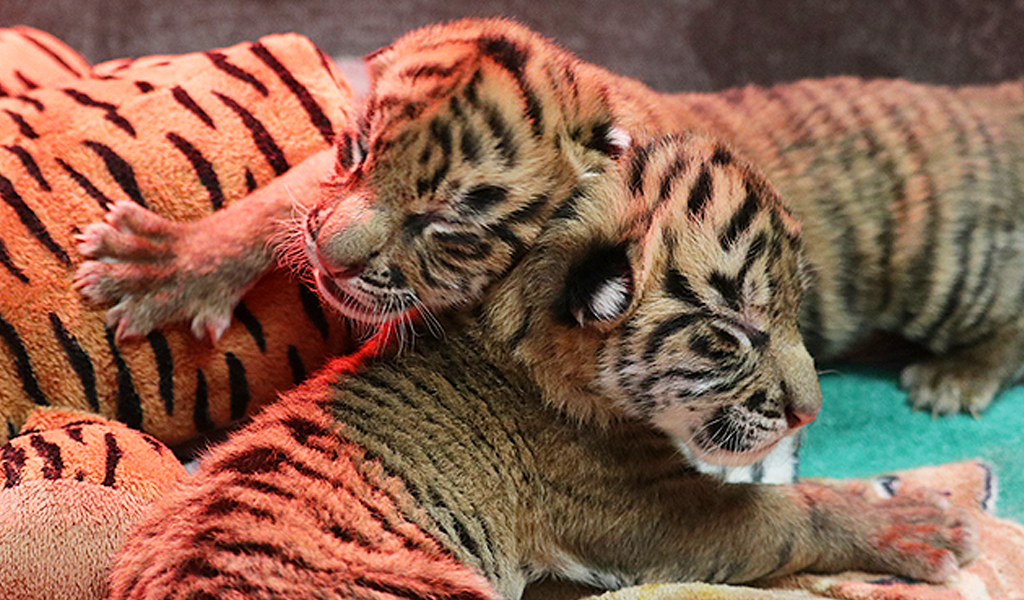
Exciting Changes Creeping into the Herpetarium
You may notice some changes the next time you’re in the reptile building. We are currently working toward theming each of the Herpetarium’s hallways with one of four conservation focuses we’ve been developing. Our ectotherms team is in the process of moving the location of several animals and updating some of the exhibits to align with the themes, in order to show how animals are affected by them.
We took this opportunity to make sure all the signs would not only be coordinated throughout the building, but also include both Spanish and English on each one, to better serve our guests. This is the first area where we’re installing bilingual signs, and we look forward to expanding that project outside of the Herpetarium in the future.
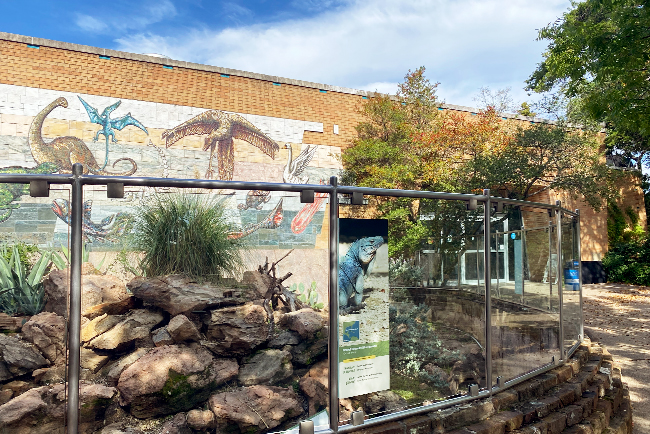
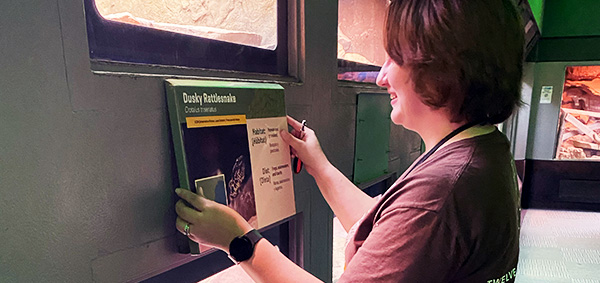
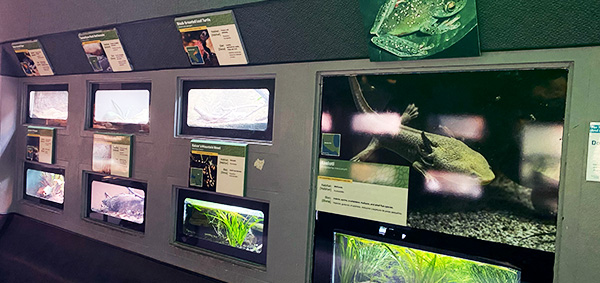
Our Four Conservation Focuses
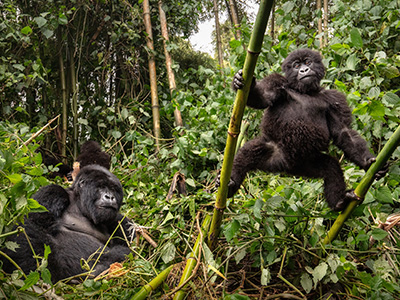
Creating Healthy Habitats
Habitats at home and abroad are directly affected by human waste, development, and overconsumption. In creating healthy habitats, we promote living in harmony with nature: preventing litter pollution and habitat destruction, while advancing habitat restoration and sustainable use of resources.

Reducing Wildlife Trade
Wildlife products are disappearing from stores but popping up online. Learn how to identify and report illegal or suspicious sales to help close the gap in wildlife trade.

Reducing Climate Change
The effects of climate change are being felt by biodiversity in every region on Earth. We can take action by being conscientious about major impact areas such as food waste, clean energy, and vehicle emissions.

Promoting Wildlife Safe Purchases
Consumers may be disconnected from where products originate and the effect their purchases have on wildlife. Choosing sustainable food helps keep our ecosystem healthy and in balance, allowing our habitats to provide for both humans and animals.
We’re excited about all the changes happening in the Herpetarium around these important conservation focuses, and hope you’ll stop by to check them out soon!
Thank you to our 2022 Sponsors
Signature Partners

Premier Partners
